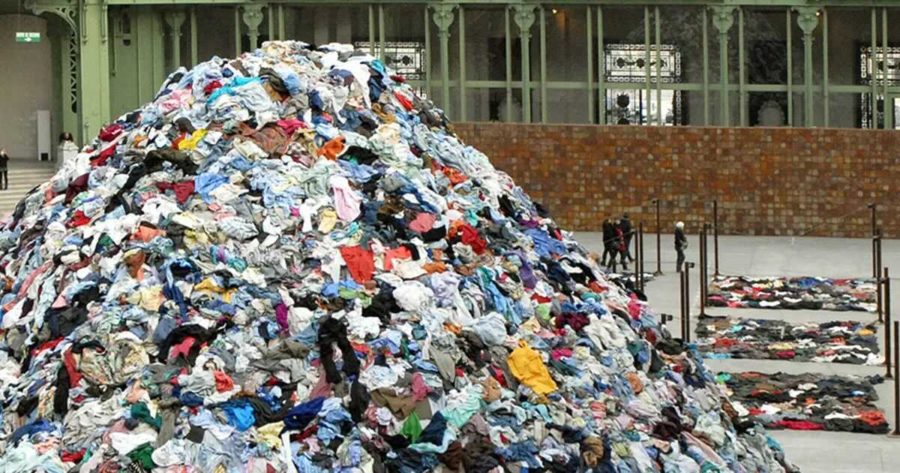The Harmful Effects of Fast Fashion
Katie Polanz writes about the global impact of current clothing trends
Advisor’s Note: This article was written by an AP Seminar student as part of a “Make a Difference” project. For the AP Seminar Performance Tasks that are scored by College Board, students spend their year researching and writing about real-world, complex issues. After the AP test, students choose one of the topics they studied and do something to raiseawareness about the issue to shed light on it as a way to make even a small difference. Students have a variety of options including developing websites, creating posters, starting social media campaigns, writing letters, and, this year, writing articles for Cardinal Nation. Student Katie Polanz chose to share her issue in Cardinal Nation. Here is Katie’s submission.
Are you a freshman? Are you looking to improve your writing, reading and even presentation skills? Well, AP Seminar would be the perfect class for you. Within the class you will conduct research and write many papers. These papers can be explanatory or argumentative depending on the assignment. They can also be about any topic you want.
One of my topics this year was fast fashion. I worked on it with a group and presented it to the class. I will now share my findings with you so you can get a better idea of what you would be doing in this class.
Right off the bat you are probably wondering, what is fast fashion? Well, fast fashion is the mass production of trending clothing sold at low costs. It is said to have started in the 80s and it grew from there. When Forever 21 opened its first store in 1984 most fashion brands released new clothing styles seasonally; however, as manufacturing and shipping became faster and cheaper, fast fashion companies offered new styles twice a week. Now, according to an article by Jane Porter, titled “See It. Like It. Buy It. Repeat. Fast Fashion Gets Faster”, with the increase in celebrity culture and social media platforms, the number of styles produced each week by fast fashion companies is 6-12. This rapid growth of fast fashion comes with many negative social, environmental and ethical connotations.
For example, fast fashion pressures people into wearing certain clothes. Many people (mainly women) feel pressured to wear popular trends, which makes them buy from fast fashion companies to “improve” their style. An Iowa State University study shows that 79% of participants learned how important appearance and clothing are from a young age. People think that if they buy the high end appearing clothing from fast fashion companies, they will maintain a good appearance and heighten other’s opinions of them.

Famous people also have an impact on fast fashion. For example, companies copy the styles’ celebrities wear and manufacture them cheaper so people can afford them. According to an article about the social impacts of fast fashion, after a celebrity posts an outfit on instagram it takes three days for fast fashion companies to replicate the design. By copying celebrity styles companies are able to sell hundreds of clothes and receive free promotion of the styles from unwilling celebrities.
Fast fashion also negatively impacts the environment. Overconsumption has led to mass amounts of textile waste in landfills, increased chemicals infiltrated into water as well as increase in released greenhouse gasses as a result of the wasteful mentality within fast fashion industries. According to Kelly Drennan, the founder of a non-profit organization devoted to sustainability in fashion companies, 200 tons of water become polluted for every ton of textile waste produced.
Ask yourself where the clothes you are wearing are from? Take a look at the tag. Chances are it is from China, Taiwan, or a sub-saharan African country, or maybe even a place in Eastern Europe. These are the places where sweatshops are most often found. Sweatshops are crowded workplaces with very poor, socially unacceptable or illegal working conditions and they are usually found within the textile industry.
A paper from the Journal of Dress, Body & Culture by Hazel Clark states, about 26 million sweatshop workers, mainly women, produce about 7 % of the world’s exported materials; those workers are often paid below living wages and suffer harsh working conditions. These sweatshops are the reason fast fashion companies are so successful. They are able to pay their workers close to nothing and then still sell the clothing for a good price.

Though fast fashion has many negative effects on the world, some may argue that it benefits society due to the large economic gains that come from it. According to a Gale Opposing Viewpoints article, over the years, the average consumer’s spending on clothing increased by roughly one-third, in direct correlation with the expansion of fast fashion. But, while this may sound beneficial it actually takes money away from smaller businesses. If people are buying from these large fast fashion corporations they will not have money to spend on these small businesses that put more money and care into the clothing that they produce.

Fast fashion is a large issue that will not go away unless people take action. Luckily, there is something you can do to help. You can shop for clothing at second-hand stores. This is a store that sells already used clothing in good condition. Some examples of local second-hand stores are Goodwill, Hope’s Treasures, and Salvation Army. By shopping at these stores you would be significantly decreasing clothing waste in two ways: one, by not buying from fast fashion companies, and two, by reusing clothing items.
If you were to buy from second-hand stores you certainly would not be the only one. The article “The Myth of Street Style” by Sophie Woodward stated that 78% of the people interviewed in a study said they regularly shop in charity or second-hand shops. You could also take it a step farther and donate your used clothes to these stores, further decreasing clothing waste. Taking these steps will help better our world one piece of clothing at a time.








